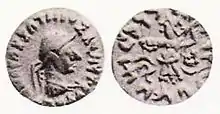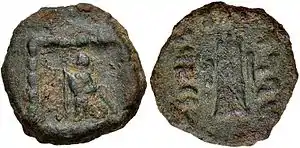Apollophanes
Apollophanes Soter (Greek: Ἀπολλοφάνης ὁ Σωτήρ; epithet means "the Saviour"; reigned c. 35 – 25 BCE) was an Indo-Greek king in the area of eastern and central Punjab in modern India and Pakistan.
| Apollophanes | |
|---|---|
 Silver drachm of king Apollophanes (r. 35-25 BCE). Obv: Helmeted bust of king. Greek legend: BASILEOS SOTEROS APOLLOPHANOU "Of Saviour King Apollophanes". Rev: Pallas with aegis and thunderbolt. Kharoshthi legend: MAHARAJASA TRATARASA APALAVINASA "Saviour king Apollophanes". | |
| Indo-Greek king | |
| Reign | 35–25 BCE |
| Died | Mathura |

Rule
Little is known about him, except for some of his remaining coins. The dating is Osmund Bopearachchi's, but R. C. Senior suggests approximately the same dates. Earlier scholars, such as Professor Ahmed Hasan Dani, W.W. Tarn and A.K. Narain dated Apollophanes considerably earlier, but the style and finding places of his coins make it clear that he belonged to the last line of eastern Indo-Greek kings, not long before they were overcome completely by pressure from the Indo-Scythians.
He may have been a relative of Apollodotus II Soter since both kings share the epithet Soter (Saviour), have names related to Apollo and use Pallas Athene as their reverse.
Coins of Apollophanes

Apollophanes issued a few debased silver drachms of the type seen above, struck with a single monogram and of little artistic quality. He seems to have been an insignificant local ruler. Apollophanes wears what appears to be a Macedonian helmet of the type seen on the Alexander Mosaic which he was the last Indo-Greek ruler to use.
Apollophanes used exclusively a single "boxy" mint-mark, in keeping with late Indo-Greek kings.[1]
See also
References
- Jakobsson, J (2010). "A Possible New Indo-Greek King Zoilos III, and an Analysis of Realism on Indo-Greek Royal Portraits". Numismatic Chronicle. JSTOR article
References
- The Greeks in Bactria and India, W.W. Tarn, Cambridge University Press.
- The Bactrian and Indus Greeks, Ahmed Hasan Dani, Lahore Museum
- The Indo-Greeks - Revisited and Supplemented, A.K. Narain, BR Publishing Corporation
- Monnaies Gréco-Bactriennes et Indo-Grecques, Osmund Bopearachchi, Bibliothèque Nationale de France.
| Preceded by Zoilos II |
Indo-Greek Ruler (in Eastern Punjab) 35 – 25 BCE |
Succeeded by Strato II and III |
- O. Bopearachchi, "Monnaies gréco-bactriennes et indo-grecques, Catalogue raisonné", Bibliothèque Nationale, Paris, 1991, p.453
- Quintanilla, Sonya Rhie (2 April 2019). "History of Early Stone Sculpture at Mathura: Ca. 150 BCE - 100 CE". BRILL – via Google Books.